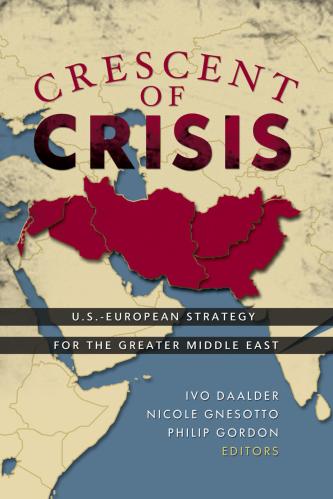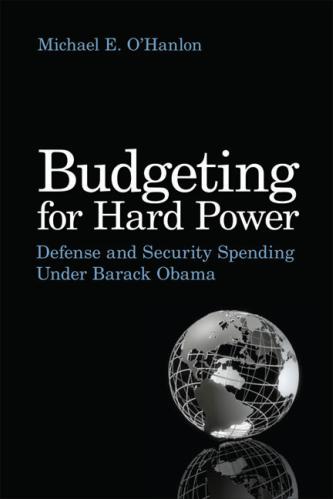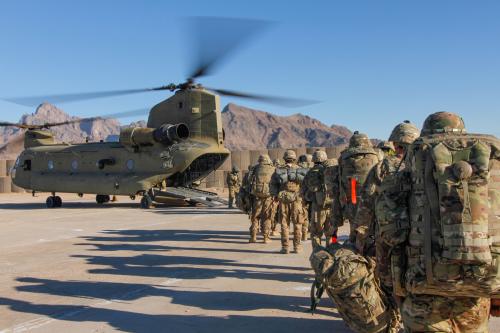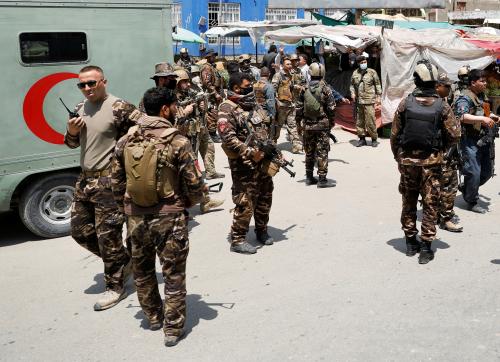It has not been pretty to watch, but it appears that the United States’ military footprint in Afghanistan policy will wind up in a reasonable place as the 2017-2021 Trump term winds down. After President Trump’s tirades and tweets on the subject helped persuade Secretary of Defense Jim Mattis to resign two years ago, such an outcome is as welcome as it is surprising. But next steps, by President Trump or a President Biden, need to be much more cautious and gradual.
Secretary of Defense Mark Esper recently announced that U.S. forces in Afghanistan will number fewer than 5,000 by the end of November. Unless big things happen on the Afghan political front, that is a good place to leave things for the foreseeable future. The next U.S. administration might even adopt a mantra of “5,000 troops for 5 years” in order to convey its commitment to an acceptable outcome of this frustrating, but far from lost, mission — and to avoid having the American president and Congress consume too much time on perpetual Afghanistan policy reviews.
Deploying 5,000 troops in Afghanistan will be a substantial reduction from the current level of more than 7,000 American troops, or the roughly 10,000 that Trump inherited from President Obama. It will be far less than the 100,000 U.S. troops during the Afghanistan surge under General David Petraeus and General John Allen back in 2011-12. It is a reasonable and sustainable figure, not unlike the number the United States deploys in several other regional footholds like Iraq, Qatar, Kuwait, Bahrain, and Djibouti today.
Many will lament that the “forever wars” would continue under such a policy. But a mission focused on training Afghans and conducting counterterrorism operations, costing perhaps $10 to $15 billion and entailing 10 to 20 American fatalities a year (if the recent past is a guide), is a far cry from the clear, hold, and build operations conducted largely by U.S. ground forces a decade ago — with American fatalities reaching as high as 500 a year and costs exceeding $100 billion annually. Compared to the alternative of an American homeland again possibly at risk from extremist attack hatched in the land of the Hindu Kush, it is likely the least bad choice.
Peace talks between the Taliban and the government of President Ashraf Ghani, representing a broader Afghan polity and civil society, may someday reach a conclusion that ends the conflict and allows the United States to leave in full. That is a worthy goal, and there have just been small steps towards that objective. A traditional Afghan “loya jirga” meeting provided Ghani cover to release the final batch of Taliban prisoners who were promised to be freed under this year’s February 29 accord between the United States and the Taliban. Real peace talks may now begin. But we are a long ways from any deal in which the two Afghan parties to the talks, both of which believe they have legitimacy and time on their side, figure out how to merge their security forces and how to share power with their dramatically different views about the future of the country. It would be a mistake by Washington to reward possible Taliban intransigence in the peace talks with a continued, steady American march for the exits. Doing so would also encourage Pakistan to continue to hedge its bets, viewing the Taliban as its safest backup plan in case the Ghani government or a successor someday falls.
Some will say that terrorism in and near Afghanistan can be checked without a peace deal and without an American military presence on the ground — even if our departure leads to all-out civil war and/or a victory by the Taliban. Perhaps any future al-Qaida or ISIS presence on Afghan soil could be handled with long-range strikes or occasional commando raids that emanate from ships in the Indian Ocean. Or perhaps we could be confident that such groups have no substantial future interest in basing themselves in Afghanistan.
But that latter argument ignores history, as well as the geographic suppleness of global extremist movements in general. Few saw the ISIS caliphate coming in Iraq and Syria before 2014, but then, all of a sudden, it was there. And the former argument shows a poor appreciation of how counterterrorism intelligence is developed — usually by cooperation with partners on the ground — as well as an unrealistic appreciation for the geographic remoteness and ruggedness of the Hindu Kush. Stand-off counterterrorism is generally an oxymoron.
With 5,000 American troops (and some additional civilians and contractors) in Afghanistan, the United States could maintain two or three major airfields and hubs of operations for intelligence, airpower, and special forces/commandos — at Bagram near Kabul in the nation’s center, near Kandahar in the south, and perhaps around either Khost or Jalalabad in the east. It also could maintain a modest military advisory and training presence in Kabul to help the Afghan army and police carry out the bulk of the fighting against extremists.
For all its frustrations, and high costs, the Afghanistan mission has not been an abject failure. The Afghan government continues to hold all major and mid-sized cities as of this writing. Even more to the point, the United States has not again been attacked by a group that plotted or organized its aggression from within Afghan borders. These are accomplishments worth preserving if they can be done at modest cost in American treasure, lives, and political bandwidth.









Commentary
Rightsizing the Afghanistan mission
August 13, 2020